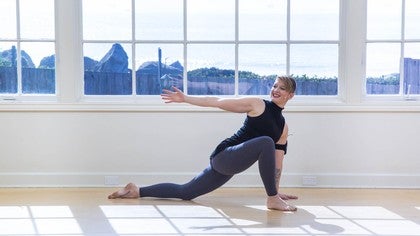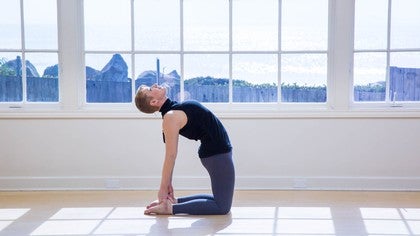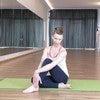Description
About This Video
Transcript
Read Full Transcript
In this class, we're going to explore the idea of bridging the gap between a time when you've fallen away from your [inaudible] practice and time when you are back into your flow. For me, whether it's been injury, illness, or even surgery, thinking about jumping back into a full movement session can be a little overwhelming. And so in this sequence we're going to explore some simple and effective ways to get back into your breath, get back into your body and remember that little spark that makes you want to jump back on that reformer. Once again, let's get started. We'll take our hands on our knees and we're just going to begin with a few deep breaths. Inhaling through your nose and just exhaling to release and let it go.
Just notice the kind of weight distribution that's happening underneath you. If you were sitting in sand or clay, what would be the impression that the weight of your body was leaving at this moment in time? And we're going to work with that idea to just shift around and reconnect with that base of support. So I'll ask you to shift over into your right sit bone. Just imagine that you're pouring the weight down into that right side and then come back to center and then shift over into the left set bone and pour the weight down and then come back to center. And it doesn't matter how you're getting there.
Use the idea of shifting and pouring weight to create a little bit more of an impression on one side or the other and see what that feels like to you. I feel and believe that when we explore how our body wants to move, we oftentimes get a little bit more information that we can draw from when we're asking ourselves to do more technique. And in this way, it's just a beautiful acknowledgment of aligning where maybe our head wants to be with where our body needs to be. So from here, let's start to shift to the right Sitz bone and then let's shift and move our weight forward to the front of the Sitz bone. Let's go to the left to this side and then to the back and we're just going to begin to make some circles around. And again, notice all of the connections you have from the base of your pelvis, the bony connections to those landmarks, and then also you can start thinking about the fleshy connections to the floor. So how heavy can you make the tissue around the bones and maybe being aware of what pieces and parts are not so willing and asking your body as you move through these motions. What do I need here? Is it released? Is it breath? Is that a little bit of nudging? Maybe is it humor, is it understanding? And let's go the opposite way.
So we'll back it up around to the right left and then all the way forward and then around. And as you start to get the sense of maybe more ease as we start to warm up the lower back and create a bit more of a base of support, perhaps you might let yourself flow a bit more. Perhaps you might let yourself enjoy the way that it feels and just notice how your body's responding to the cues. Good. And so let's do one more and we'll come back to center. And just once again feel the base of support. How has it changed for you?
What are you more willing to engage into now? And we're going to take this exploration into a bit of a figure eight and you'll see this shape come up a bit more in this entire movement sequence. So we're going to bring it around to the front of the right sip bone to the right of the sit bone, behind the sit bone, to the diagonal, towards your left knee, and then around, back behind and through. And maybe we'll let the arms come out to the side to just help us. Don't worry about your eight being perfect, don't worry about it being the actual shape.
Just see if something in this motion starts to awaken something in your center. And that what's so interesting to me about exploring these different motions that may be different than PyLadies or maybe even a little awkward to your body at times, is that when we disconnect from a movement practice, we also disconnect from some awareness that's happening in our body. So any way that I can send an invitation through doing something that maybe is unexpected to my body that my brain will pay attention to is for me a welcome opportunity to gain more awareness for what's happening. Good. All right, let's come back to center and we'll just uncross and re cross the legs for balance. And now we're going to just begin to invite the spine and to dance with the hips.
So let's round the spine forward over the legs and just trace the arms and see where that weight transfer goes to and then roll up through the spine. You can use your one bone at a time and then allow the spine to bend back words. So the theme of this motion is just reminding your spine that it has mobility to it, reminding your hips that they can move, reminding your body that there potential possibility. And we tend to forget about those things sometimes when we're out of our practice or think that movement can only happen in one way. But the truth is is that we have infinite possibilities.
So as you're rounding in, extending your spine starts to think about how you could talk yourself through this movement. Start to think about like what is it you feel? Oh Wow. Spine, you're bending forward really nicely today. I'd love to get a little bit more movement in the middle of my back and a Oh, interesting. Right side. You seem a little bit more willing to back. Bend them the left. I wonder what's going on there? No need to figure it out. Just to work through. And then we'll come back to center.
And something that I like to do is just explore a little shivering up the spine. So we're going to just rock the pelvis back and forth. And if you think about that emotional response to something important or exciting, it's a little shiver up the spine. And I want to see if we can just experience that from a movement perspective. So we're just going to Shimmer it, shipper the pelvis and take it all the way up and take the arms up and just see what's happening.
As we kind of challenged those little muscles and bones to move around and then quiet yourself down at the bottom and then just like you're coming to a boil, just shiver, send shivers up your own spine. Allow yourself to shake, allow your tissues to move and come back to center. And let's just do that one more time. Take a deep breath in. Can you shiver your breath as you're shivering, your movement? Good and come all the way back down to center.
And then pay attention once again to the base of support and we'll roll back up from here all the way to the top. From here, let's close the legs up. We're going to come all the way down to the back. So nice and easy roll down one bone at a time or whatever allows you to feel really balanced and centered. You can have your arms out on the mat and then walk your feet in relatively close. So we're going to just experience a simple knee drop and opening of the right leg towards the floor.
And the idea here is just what's available to me in this motion within my hip without letting the whole body come over just yet. So it's inventory. You know what happens when my knee opens? Is Everything and coming along with it or is it just simply available to open in the joint and come back up? And another thing that's interesting about just exploring this motion is where is your initiation coming from? So for some of us, it will happen high in the hip socket. For others that'll happen to the outer hip. For some, you might even explore turning the sole of the foot upward towards the ceiling and open in order to facilitate a bigger opening of the hip.
We're not forcing necessarily or muscling our way through. We're just seeing what's there and what's available to us. Then come all the way back and then we'll go into the other side. So picking the strategy that worked well for you on the other side is a great thought process, but also recognizing that sometimes the two sides need a little different. Motivation can be very, very useful.
We always have two hips that have two different experiences, even though they're in the same body. And so treating them according to their own needs is definitely welcome. So if I'm coming back from something where my center has been compromised, maybe it's pregnancy or any number of, uh, setbacks. One thing that I really love to experience is the rolling of the hips with the knees. So I like to use that idea of pouring the weight into the right side, rolling over. And just as I'm going, I'm questioning is this, is this alright? Is this okay? Is this all right? And as I go over, I'm also noticing how far my body is willing to go. And just taking that in and coming back by pouring the weight back to the center and to the opposite side. And so the first couple times that are role, it's really a chance to check in with what's happening in my hips, in my lumbar spine, and also in the space in my brain that might have a little fear surrounding rolling.
So if I feel a strong contraction or stop or fear response, I'm going to stop in that moment and just breathe into it or ask my body what is, what do you need? And that is probably one of the most important parts of my practice is to consistently check in and say, what is it you need in this moment? And as time goes on and I feel that there is a sense of welcoming, then I might ask the weight to go a little farther. I might bring my knees actively over to the side to experience a stretch and see if that works for me than it does. And again, just consistently checking in with the needs and wants.
And the great thing about getting in touch with your rolling mechanic if you will, or your rolling abilities is that you can really go places from your rolling. So what we're going to do is transition this rolling into a bit more movement from side to side to all the way over to this side. So this time as you roll over onto your right hip, maybe you'll sweep your arm up and come back. You can see what that feels like and then as you come back, come back to center and then try it also on the other side and just let it be what it is. A really nice place for exploration is also to check in with the ribs.
How are the ribs willingly rolling willingly accepting weight and how are they maybe being a little bit hesitant. And then again where are you initiating this from? Where's the impetus for the role? How is it showing up in your body? Is it a back extension? Is it a push, are you able to roll like you're a bit of a bag of bones. We'll do one more each side.
And if you are working on the floor or carpet, you're probably getting a little bit of relief on the side of your hip too. So from from a rolling onto the side, what we'll do is we'll allow the back arms to come forward and we're just going to see what it's like to come up into a seated position. And then we're going to come all the way back down and then we're going to roll back on the back and just pause and then go to the other side. Rolling over, sneaking that arm, coming up to sit. So the idea of the goal if there is one, is to just allow this to be as easy as possible as you begin to flow through the motion.
Start to release the pieces and just see if there's a way to shift your weight from side to side, from hip to hip, from shoulder to shoulder. And how does that help you move the body weight that you have available to you up and off of the floor.
And so if you are working through your own process, let it be your process, insert your name here, we'll do a couple more reaching and rolling to the side
Be Weighted in heavy in your shins. Take a deep breath and expand your back. And as you exhale, press into the hands, press into the shins and just peek underneath. See what's happening. Let the back of your neck extend, stretch and just open up. Feel your spine pressing up through your shoulder blades. Feel your lower back widening from side to side, and then watch your hips and begin by flipping your tail upwards, crease in your hips.
Extend and reach forward and make adjustments on the way that allow you to feel more grounded and more definite in your shape. Rounding up, playing with waiting different knuckles, what's offering you a bit more feedback to your body, reaching to the sky. And let's take two more of these. Rounding
And then bring yourself all the way back down and round. And let's do that a few more times. So reaching and just coordinating what needs to happen in my spine in order to open my chest. And then how do I pull myself back together? And again, maybe I've notice that my spine would like to lead this movement, which is just fine.
We will bring the arm back down and we'll round up to the top and then we'll extend. We'll open the arm, we'll shift weight isn't an interesting, that one side is a little more willing to support us and then bring the knee back down and the arms. Let's do this a few more times. Extend your arm, shift into your leg. You could actually stand that foot down. Reach through the knee, we and all the way down. So I'm learning right now, lots of things and I hope you are to me and rounding one more time. Let's open the arm that's open the knee. And then what would happen if we just lowered it down to sit.
And then from here, how could we press up using the basis of support, reaching to the sky, lower the knee, lower the arm, come back into our little rounding shape, open the arm, open the knee. What would it be like to just shift your weight and set lifting up knee and arm and just like the rolling we did earlier, is it possible to bring in some level of flow and [inaudible] what begins to work better for you? So we're qualifying this through a lot of support work through the back, through the side body, and just also changing levels. We haven't yet gotten up from the ground. We will soon, but we want to get in touch with what it feels like to be up. One more level. Good.
Let's come back and round our spines and extend working the breath that supports you in this motion and extend. So from here, let's come back into the center. I'm going to walk my hands a bit forward of my shoulders and going to attempt stepping forward into a lunge. Now what I will say is try to just trust that you can do this because the idea of bringing your foot by your hand can be a little overwhelming at times. So what I'm gonna do is rock back and rock forward, rock back and rock forward. And then I'm going to do one more.
And as I wrecked forward, I'm just going to stand. Boom. Simple. Come back, rock back, rock forward, Rock, back, rock forward. Rock, back and stent. Not as simple, but it works. Rock back and forward. Rock back and forward. Rock back and stand. Let your foot take weight. Rock back and forward. Rock, back and forth. Rock back and lunch. Okay, let's see if we can rock back. Step forward.
Rock back, stepped forward. What needs to happen for you to move and cover space from your hips and cover space with your legs and shift your weight into your hands. One more each side. We'll take the last one forward to step. And from here, we're going to open the arm. We've already gone here. We're just going to reach into a nice stretch. Circle it back, look behind you.
If you can reach it up, round your spine just a little bit. Poor weight into that right foot as you push and round your upper back. And when, let's extend and stretch again. Lifting it up to circle back, reaching up and round and press one more time. Reaching up and circle back, reaching up and round and press. And then from here, come into your flat back. Shift your weight forward, coming back, pressing forward, and to the left foot. Circle it right away. So around up and circle back, round up and push and stretch.
Allow your hips to be heavy. Thinking about this as an exercise with gravity. So just what happens as I allow all the points that are supporting me to be connected to the floor. One more time. Reach and extend. Lift and round. Shift my weight forward.
Coming back. Okay, so the big ask is to see if we can come forward into a bit of a squat. So once again, we're in our hands. We're going to see if we can bring our right foot forward and then we're going to see if we can bring our left foot forward. But let's do those rocks again. So we'll go backward and forward second time and forward third time and for it, I guess we're going to do four, four time and step. And then from here what has to happen?
I'm going to move my hands forward in order to bring you into your squat, whatever that means to you. Forward hands, maybe your heels are lifted. Whatever you need to do. And we're just gonna kind of move that squad around a little bit and see what's available to us. We're not getting married to the holding of the squat necessarily. We're just kind of exploring our footprints.
We're bringing ourselves into an understanding of what it means to be in deep hip flection and also kind of like what's available to me here. Can I release my hands? Are My hands on my knees? Do I need my butt up a little higher in the air? What do I have right now? Good. From here, we're going to press the legs straight and rotate into parallel. Let's just take a couple of knee bends, bending, dropping the hips, almost letting your torso rest on your thighs, tilting your hips up to the sky, sitz bones reaching up and bending.
And I'm practicing with my fingertips right now. I actually like waking them up too because they're there. And you can also pour weight into your hands if that feels a little bit more supported for you. Last one up and bend. And then let's slowly roll up and just pause about halfway.
So how your upper body is releasing. Notice how your lower body is responding. Where is there an opportunity to put a bit more weight into certain parts of your feet to get more support? And then can you enroll from here all the way to the top. And from here, let's go ahead and just take a wide stance.
Something that's similar to this squat that you just did and we're just going to explore what's it like to get from way up here to way down there. So let's reach the arms up to the sky. And then I want us to kind of fold in. Bend the knees, lower down, take the hands to the ground, send the legs to straight, roll all the way up, and we can do that with a little bit of a ripple. So we're reaching up to bend to lower touch, to roll to the top. We lift and down and reach. And again, it's not important what the arms are doing.
It's just a way of like just becoming more mobile within your own space and remembering that that body is connected. Maybe confusing it with the little pattern that it's never done before. We'll do two more of these reaching, lowering all the way down. Don't get wild with it, and lower and straighten. Hand rotate back in. Bend your knees and roll all the way up to the top.
All right, so we're standing. We're almost ready to kind of move out into the world. And something that I really like to do to remember all of the wonderful connections and support I have in my hips is to try little standing figure eight. So this is where you get to dance on one leg. Nobody's watching. It's going to be great. You can take your hands on your hips, you can just allow the other foot to come up and off with. Find that balance. Little bend of your supporting leg.
Picture that your pelvis is going to be making a figure eight on top of your femur. So like we did before, let's just go in the same direction. We're going to move the pelvis forward to this side, to the back, through the diagonal to this side. That's where it gets sexy to the back through the diagonal, forward to this side to the back. Doesn't matter what it looks like. You're just trying to keep it really in a stealth but direct.
And then if it feels like you can make it smaller and you might do a little release with the hands, there's one little roadblock that I have. I'm trying to get in there. Good Woo and around and then stand on it and just notice the connection from the entire side of the leg. You were standing on down into the floor. What's the difference in the footprints and which one do you like better? That's always a big question for my body. Do I like the way I feel?
Do I want to do it more sweet? Good. Cause we have another side. So pour the weight into the other leg, a little bit of weight down into there, a little bit of bend, excuse me. And then just find your, find your balance, feel your connection and begin that figure eight in whatever way makes sense to you. So essentially two circles that connect through a diagonal. And when you feel like you're a little more able, exploring that with a little more freedom in the arms and maybe there's an opportunity for you to add an arm on at no, you're in your home. I'm here. You can do whatever you like in this moment.
Beautiful. Let's go to more and find it and stand on it. Just take a second to stand into your body. For me, I like to remember in this moment that this is the one I have. This is the one that's been there for me. This is the one that I'm going to ask to get back into that practice real soon.
But I'm also going to attend to her needs. And so whatever chatter might be left over in my head about what we did or what we're going to do. I'm just going to use a movement metaphor to brush it off. So as we finish, I'm just going to brush down my arm. Just brush, get outta here. We are only interested, good, nourishing movement and go to the other one. Just let this be a release of all of the things that have been holding you back and all of the roadblocks that might come into play in the future. I like to brush across my belly, let it go.
Maybe you brush a little bit across your heart, maybe your brush your face up into a bit of a smile a little bit. It's reached down. Brush the leg up and then throw it away. Rush it up and throw it away. One more, brush it and throw it away. And then let's go to the other side. Reach down and throw it away and brush it up and throw it away. One more time, brush it up, throw it away, come back into center and let the back of your legs go.
Creating a lots of energy and lots of space for the possibilities that are yet to come all the way down. Pay The calf. So I'm just going to warm these guys up because they like to hold on to a lot of that chatter and then we'll just release it and finally bring your hands together. Just create some heat. Let your body slowing it down and just allow it to slow down to a moment where you can take a rest and just hold that same something wonderful in the palm of your hands that you thought earlier as we opened the chest to either side, just take a deep breath in and exhale. Breathe into that space that lets you know that you're ready to move ahead no matter if it's a baby step or a big old leap. You've taken the time to address some of the conversations that you have with your body and you're letting yourself take one more deep breath in and then just open your arms and an offering, an acknowledgement that you are back in.
And I look forward to hearing about how your next session goes.
Mindful Movement - Playlist 5: Reconnecting to You
Comments
You need to be a subscriber to post a comment.
Please Log In or Create an Account to start your free trial.

































